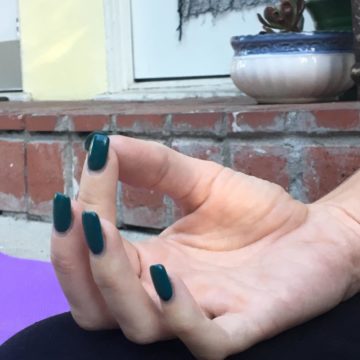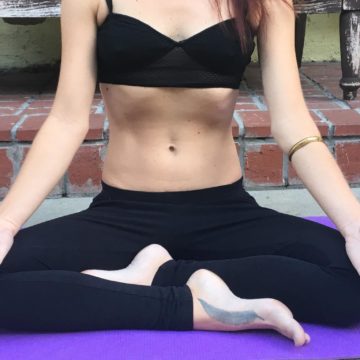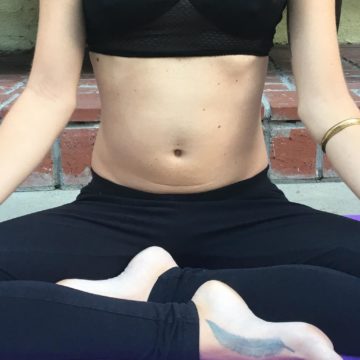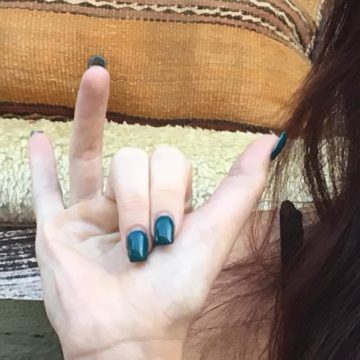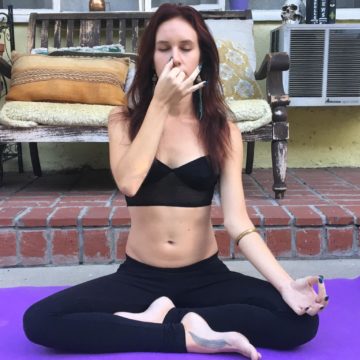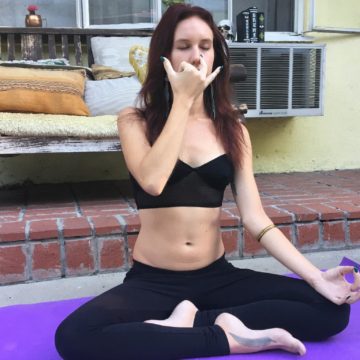Most people use only a fraction of their lung capacity. We often sustain ourselves with breaths that are shallow and quick, causing us to suffer from lack of oxygen. Basically, most of us are not giving our breathing the attention it deserves!
A couple of years ago, I decided that it was time to take initiative to create some positive lifestyle changes for myself. I began a regular yoga practice that focused heavily on pranayama breathing techniques. After several months of practicing breathwork daily, I changed my life! Pranayama produces TREMENDOUS benefits for the body and mind. The breath connects the body to the mind and the mind is the connection between body and spirit. Through pranayama, we can become conscious of our breathing, calm the mind and access the higher spiritual levels of our being.
Prana-what? According to the Yoga Sutras, an ancient yogic text composed almost 2,000 years ago by the Sage Pantanjali, pranayama is a fundamental part of the eightfold path. The Sanskrit word prana is defined as “life-force energy”. Prana is the sum total of all energy that exists in the universe. All living things contain prana, or energy. If the movement of the lungs is stopped, all other energy and functions in the human body will stop. Ayama means “expansion” or “movement.” By practicing pranayama, we learn to expand the subtle prana that is within us. Regulation of prana leads to understanding of the mind. Once the mind is balanced, we begin to form the connection to our individual soul and then to the soul of the universe.
It is most effective to practice pranayama early in the morning or in the evening around sunset, when the earth is the most energetically charged. This will not only allow you to begin or end your day with powerful health benefits and a relaxed state of mind, but it creates a habit which leads to a consistent practice. Next time you reach for a cup of coffee in the morning, try replacing the caffeine for one of these 3 powerful pranayama breathing techniques to start your day with vitality and awareness!
Kapalabhati This is my favorite pranayama and it is how I choose to begin each day. It is actually one of the shat kriyas, meaning one of the six purification processes in Hatha yoga. It is an energetic breath with a forceful exhalation and a passive inhalation. Kapala means “skull” and bhati means “shining.” Kapalabhati is so cleansing–don’t be surprised when your face and eyes begin to shine with good health and radiance! This technique revitalizes the internal organs, particularly the brain, by sending them freshly oxygenated blood. It removes toxins, stimulates the nervous system, increases pranic flow and accelerates mental awareness. Wait at least 3 hours after eating to practice kapalabhati.
Instructions
Start in a comfortable seated position with the spine straight, either on the floor in sukasana (easy sitting pose) or sitting upright in a chair.
Bring the hands to chin mudra, index finger and thumb touching, palms facing upward, eyes are closed.
Take a few slow, deep inhales and exhales.
Begin by forcefully exhaling through the nose while contracting your low belly inward at the same time.
Take a short, passive inhalation through the nose while the belly relaxes in a neutral position.
Continue this rhythm of exhaling and inhaling while pumping the abdomen for 3 rounds of 20, 30 and then 40 exhalations. Increasing the amount of exhales as you progress and taking a series of long, full breath between each round
Bhastrika This technique is basically an amped up version of kapalabhati. It is an active, dynamic pranayama that involves a forceful inhalation and exhalation. The Sanskrit term bhastrika references a bellows used by a blacksmith to enhance the fire in a furnace. Bhastrika dramatically increases the flow of air and prana while producing heat in the body. Toxins are burned and digestion is stimulated. It produces rapid energy and aids the circulation of the blood. Bhastrika improves the nervous and respiratory systems and induces clarity of thoughts and concentration. Do not practice less than 3 hours after eating.
Instructions
Begin in the same seated posture as kapalabhati taking chin mudra, palms face upward, eyes closed.
Take a few deep breaths in and out to prepare yourself.
Begin forcefully inhaling and exhaling out of the nose while pulling the navel point inward during the exhale, belly relaxes on the inhale.
Continue pumping the breath for 3 rounds of 10 exhales each, resting and taking slow, deep breaths in between each round.
Nadi Shodhana This is a balancing pranayama that produces tranquility of the mind. It is also called alternate nostril breathing. Nadi means “channel” and shodhana means “purification”. The primary function of this breathing technique is to purify the 72,000 nadis (energy channels) of the body and to balance the ida and pingala, which are two specific energy channels that govern the feminine and masculine energies of the subtle body. It is also believed to balance the right and left hemispheres of the brain. Nadi Shodhana strengthens the lungs and respiratory system and puts the mind at ease. Wait 1 hour after eating to practice this technique.
Instructions
Start by sitting comfortably in sukasana or in a chair with the spine straight, eyes are closed.
Place the left hand into chin mudra and the right hand takes vishnu mudra, the pointer finger and the middle finger are turned in toward the palms while the other three fingers remain extended.
Holding vishnu mudra, bring the right hand toward the nose.
The thumb closes to right nostril, inhale slowly and gently through the left nostril.
Closing the left nostril with the ring finger, exhale through the right nostril.
Cover the right nostril, inhale through the left nostril.
Close the left nostril and inhale through the right side.
These instructions indicate one full cycle. Continue this practice of alternate nostril breathing for 5 to 10 cycles. Each exhale should be double the length of each inhale.
Cautions Rest lying down on your back in savasana (corpse pose) for a few minutes after practicing pranayama. Avoid kapalabhati and bhastrika if you have high blood pressure, heart disease, hernias or if you are pregnant. Practice ahimsa (nonharm) to yourself during pranayama by accepting your limitations. It is best to consult with a certified teacher as you advance in your pranayama practice.
Also by Ally: Manifest Success With This Empowering Ganesha Mantra
Related: Why Mindful Eating Is A Balm For Anyone Who’s Ever Battled Disordered Eating
How I Learned To Breathe After I Stopped Dancing
Get more like this—Subscribe to our daily inspirational newsletter for exclusive content!
Photo: Dave Santonil; Ally Snead


